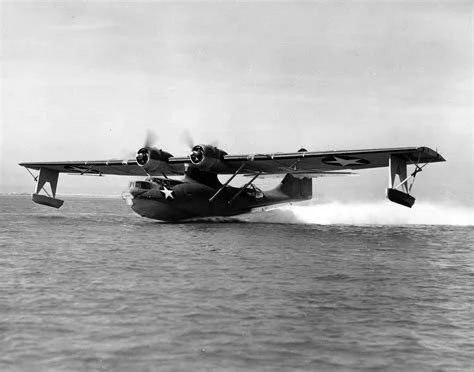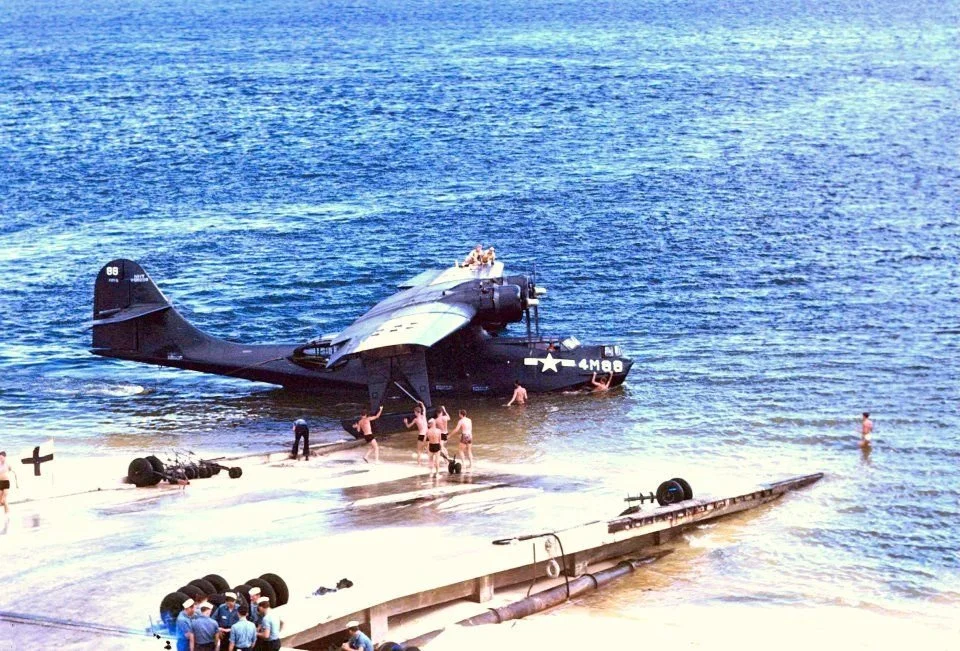The PBY Catalina: The legendary flying boat that rescued Quint in JAWS
“ Noon, the fifth day, Mr. Hooper, a Lockheed Ventura saw us, he swung in low and he saw us, a young pilot, lot younger than Mr. Hooper here, anyway he spotted us and three hours later a big ol’ fat PBY come down and started to pick us up. You know that was the time I was most frightened. Waitin’ for my turn. I’ll never put on a lifejacket again. ”
PBY Catalina makes a water landing
Origins and Development
The Catalina was developed in the 1930s by Consolidated Aircraft in response to a U.S. Navy requirement for a long-range patrol bomber. First flown in 1935, the PBY (standing for "Patrol Bomber, with Y being the manufacturer's code for Consolidated") was designed as a flying boat capable of operating from both water and land (in its amphibious versions).
The aircraft’s name, “Catalina,” was adopted by the British Royal Air Force and later used universally. The design featured a parasol wing mounted above a hull-shaped fuselage, twin radial engines, and retractable wingtip floats that doubled as wingtips when in flight.
Roles and Capabilities
The Catalina was renowned for its versatility. It was used in a wide variety of roles, including:
Maritime Patrol: With its long range and ability to loiter for extended periods, the Catalina was ideal for oceanic surveillance and anti-submarine warfare.
Search and Rescue (SAR): Dubbed the “Cat” by many of its crews, the Catalina was used extensively to rescue downed airmen and stranded sailors. Its ability to land on water made it indispensable for wartime air-sea rescue missions.
Transport and Cargo: It could carry personnel, medical supplies, and cargo to remote island outposts or areas without developed runways.
Reconnaissance and Espionage: Some Catalinas were equipped for photo-reconnaissance or modified for covert operations, including inserting spies behind enemy lines.
Wartime Service
During World War II, the PBY Catalina saw service in every theater of the conflict. Perhaps its most famous moment came during the Battle of Midway in June 1942, when a Catalina patrol spotted the approaching Japanese fleet, enabling the U.S. Navy to prepare and ultimately turn the tide of the war in the Pacific.
Catalinas were also responsible for sinking numerous enemy submarines, particularly German U-boats in the Atlantic. Their slow speed made them vulnerable to enemy fighters, but they often flew missions at night or from remote locations to reduce risk.
Variants and Production
Several variants of the PBY were produced, including:
PBY-5: A pure flying boat variant.
PBY-5A: An amphibious version with retractable landing gear for operations from land or water.
PBY-6A: The final production version, with improved radar and defensive armament.
More than 3,300 Catalinas were built by Consolidated and under license by other manufacturers, including in Canada (as the Canso) and the Soviet Union.
A PBY Catalina getting ready to be pulled ashore in the Aleutian icy waters.
Post-War Service and Legacy
After the war, many Catalinas continued to serve in military, civilian, and commercial roles. They were used for firefighting, exploration, survey work, and as transport aircraft in rugged or remote areas. A number of Catalinas are still flying today, maintained by private collectors and aviation museums, and are a popular attraction at airshows.
The aircraft’s reliability, long range, and adaptability made it one of the most important maritime aircraft in aviation history. The PBY Catalina is remembered not only as a workhorse of war but also as a symbol of ingenuity, resilience, and lifesaving heroics.
Conclusion
The PBY Catalina was more than just a flying boat—it was a lifeline during war, a pioneer of long-range air travel, and a testament to the golden age of aircraft design. Its contributions to Allied success in World War II and its enduring presence in peacetime missions make it a true legend of the skies and seas.
If you would like to write for The Daily Jaws, please visit our ‘work with us’ page
For all the latest Jaws, shark and shark movie news, follow The Daily Jaws on Instagram, Twitter and Facebook.



